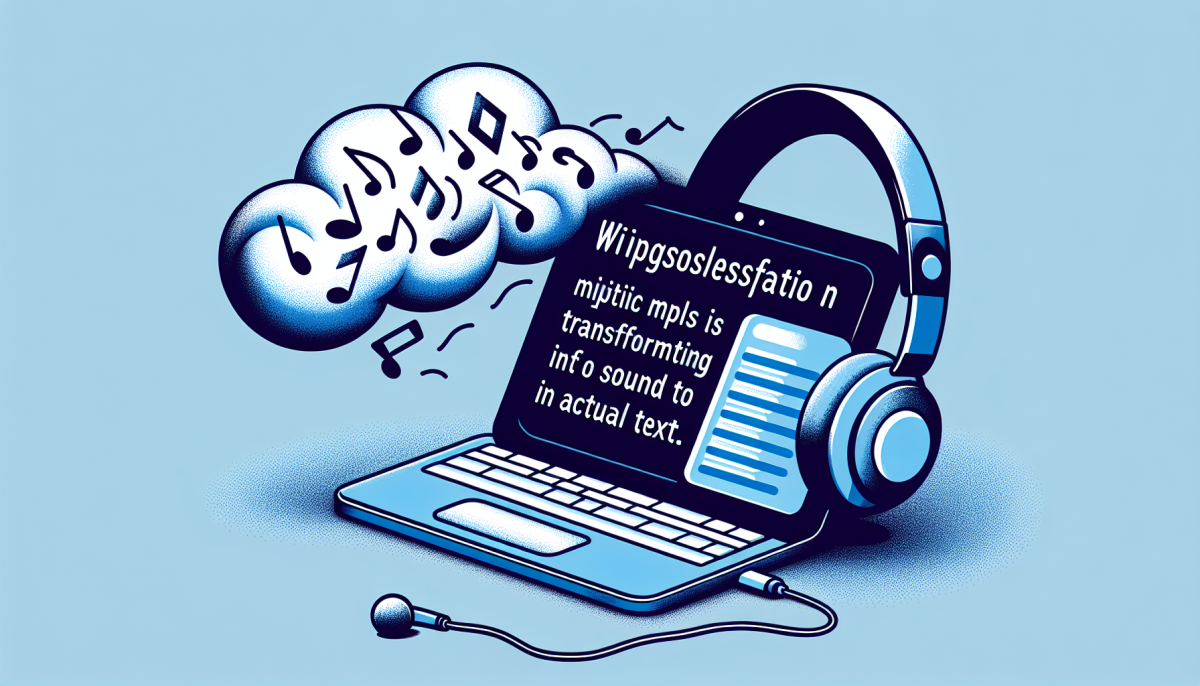Unleash the untapped potential of your MP3 files. Discover the transformative magic of turning your audio content into engaging blog posts, amplifying your reach, and reshaping your content strategy. Dive into the universe of transcription and repurposing with our comprehensive guide on turning your MP3 files into compelling blog posts. Turning MP3 files into blog posts leverages the power of repurposing content, allowing audio materials to reach a broader audience or be accessible to those who prefer reading and potentially increasing website traffic and engagement.
Importing Your MP3 File
Venturing into the world of digital audio files, mainly MP3s, requires mastery over a few essential tasks, foremost among them being file importation. This section aims to guide you through locating your MP3 file, uploading it to your desired platform, and understanding the often perplexing world of upload notifications and errors.
Locating Your MP3 File
In order to import your MP3 file, it is crucial to first locate it on your device. Whether your MP3 file is saved on your computer, smartphone, or external storage device, the precise steps for locating it may vary according to the device’s unique operating system.
For instance, utilizing the Files Explorer search bar on Windows PCs might prove handy, while a Finder window could be employed on Apple devices for a similar purpose. Moreover, your file might be in the Downloads folder or, perhaps, in a music-labeled directory you previously created.
Once the file is located, verify its name and play it back to ensure it is the correct one. Knowing where your MP3 file is stored will not only aid in its successful importation but also enhance your overall organizational abilities, making the full use of your device simpler and more efficient.
Uploading the MP3 File to the Platform
Initiating the process of uploading your MP3 file to your desired platform signifies a crucial phase in importing your MP3 file. As a preliminary step, ensure that your file follows the accepted standards, such as being in an .mp3 format and not exceeding the size limit stipulated by the platform.
Then, navigate to the upload section of the platform, select your file, and click on the ‘Upload’ button. This process might slightly differ depending on the platform used, yet the foundational steps remain quite similar.
The time taken for the upload process depends on both the file size and your internet speed, so exercise patience during this process. Regularly updating the browser and having a stable internet connection can facilitate a smoother, error-free upload process.
Understanding Upload Notifications and Errors
Understanding the details of upload notifications and error messages is crucial to successfully importing your MP3 file.
These notifications act as real-time guides, indicating the progression of your file import or pointing out any potential issues that may have interrupted the process.
For instance, if your MP3 file format isn’t compatible with the system or the file size exceeds the limit, an error message will be prompted, pinpointing the exact problem for an easy resolution.
Constant notifications maintain smooth transitions between these stages, ensuring that users aren’t left in the dark during the process.
However, it’s important to interpret these notifications correctly for a seamless and successful MP3 import experience.
Adding Customizations to Your Content
Enriching your content through accurate media selection can elevate engagement and make your message extraordinarily compelling. This section delves into effectively incorporating assorted media, tweaking your customization settings and preferences, and confidently confirming and generating your content masterpiece.
Selecting Media
Selecting the appropriate media forms part of the crucial steps towards enhancing the customization of your content.
The choice of media can significantly influence how your audience perceives the message.
For instance, a simple text message can transform into captivating content with elements such as videos, images, infographics, and even audio clips.
In one study, Infographics were found to increase web traffic by up to 12% (The Savy Marketer, 2021). Therefore, when planning to customize your content, taking the extra step to incorporate appropriate media can make a substantial difference.
As you transition to the next stages of customization, remember that your choice of media should enhance the overall user experience, not distract or detract from your main message.
Customization Settings and Preferences
In the realm of content creation, harnessing the power of customization settings and preferences can provide heightened user engagement and a more personalized experience.
For instance, changing color schemes, toggling between light and dark modes, or deciding the content layout can remarkably enhance user interaction rates.
According to a study by Epsilon, 80% of customers are more likely to do business with a company offering personalized experiences.
Furthermore, transitioning to another critical consideration, these settings add value to the user experience and reflect the brand’s willingness to accommodate varying user preferences and needs.
Thus, properly implementing customization settings and preferences plays a pivotal role in content tailoring, making it an absolute necessity in today’s competitive digital space.
Confirm and Generate
Once you’ve completed adding your preferences and necessary amendments to your content, the next step is the ‘Confirm and Generate’. This is vital to keep in mind that customization doesn’t stop at editing; every change should be accurately reflected in your final output.
At this stage, you can review all your customizations, providing an overview before finalizing.
For instance, if you’ve implemented SEO keywords in to enhance your content’s online visibility, you should re-check their proper placement and effectiveness.
Ultimately, the smooth transition from confirming alterations to generating the final version of the content ensures a successful output, creating a synergy between your unique style and the content standards required.
Exporting Your Generated Article
Diving into the nitty-gritty of article generation, one crucial feature stands out—the exporting process. This section aims to guide you through the essential steps, starting with preparing your article for export and selecting your preferred format and continuing through to completing the process, ensuring seamless integration into your unique workflow.
Preparing Your Article for Export
As you near completion of your article, preparing your work for export is indispensable in maintaining its format and readability across different platforms. This process requires meticulous inspection of your document in several key areas.
For instance, ensure the text is devoid of typos and grammatical errors, carefully choose suitable fonts and sizes to maintain the article’s aesthetic on various platforms, and confirm that any inserted graphics or images are correctly aligned with appropriate resolutions. Moreover, it guarantees the documented sources are correctly cited and formatted.
Thorough preparations will enhance your article’s professional appearance and minimize the potential issue of misinterpretations or modifications when exported. Adopt smooth transitions and continuity in the paragraphs, eluding abrupt changes, links, breaks, or jumps that could tilt the flow or balance of the article.
An excellently prepared article for export embodies a well-structured article, coherent arguments, and substantiated information.
Choosing Your Preferred Format
Deciding on your preferred format is essential when exporting your generated article. Your choice will largely depend on your desired presentation mode or the requirements specified by the platform where your work will be published.
For instance, a PDF format preserves your article’s layout and formatting, making it ideal for printing or professional presentations. On the other hand, .doc or .docx formats are best if further modifications are needed before finalizing due to their compatibility with numerous text editors.
HTML format lends itself to online publication, as it maintains hyperlink functionality and can easily be embedded into web pages. Evaluate your needs carefully, examining factors such as ease of distribution, potential re-editing needs, and platform requirements.
Remember, choosing the correct format is just as vital as writing the article.
Completing the Export Process
After generating your article, completing the export process becomes the next vital step you need to tackle. To initiate the process, locate and click on the ‘Export’ button, which is usually situated at the top right corner of your software program or browser.
This typically prompts a dropdown menu with different format options such as PDF, Word, or HTML. Choose your preferred format, download the file, and save it in your local storage or preferred cloud platform.
Remember, exported files retain your work’s overall style and format, supporting seamless integration into your existing files or templates. A thriving export process ensures that your well-crafted thoughts and ideas are preserved and ready for distribution, closing the final step of your content creation cycle.
Setting Up Automation for Quick Content Creation
Paving your path to rapid content creation, the power of automation cannot be understated. In this section, we will demystify the process of setting up automation, starting with its significance, the initial steps to get you running, and the key to managing and tweaking this automation over time.
Understanding the Importance of Automation
Understanding the importance of automation is the first step towards quick and efficient content creation. Automation technologies streamline the content creation process, reducing time-consuming manual tasks such as keyword research, content formatting, and analytics tracking.
As a result, content creators can focus more on creative creativity and strategy. A report by McKinsey & Company revealed that automation can save up to 20% of a content creator’s time, demonstrating its significant impact on productivity.
Intelligent automation tools and platforms also offer advantages such as consistency in content, quick turnaround times, and scalability. Therefore, integrating automation into your content creation process is worth considering.
- Understand the importance of automation for efficient content creation.
- Use automation technologies to reduce time-consuming tasks like keyword research, content formatting, and analytics tracking.
- Consider integrating automation tools and platforms into the content creation process for benefits like consistent content, quick turnaround times, and scalability.
Setting Up Your Initial Automation
Setting up initial automations plays a pivotal role in expediting the content creation process. To begin, it’s crucial to identify recurring tasks in your content production workflow, such as posting to social media platforms or sending emails to subscribers, and apply automation to these processes, thereby saving time and enhancing efficiency.
For instance, tools like Buffer or Hootsuite can help automate social media posts, while email marketing platforms like MailChimp provide automation features for scheduling and sending emails. In addition, Google Alerts can be configured to notify you about current trends matching your set keywords, automatically keeping you updated with relevant content ideas.
These initial automation steps streamline your content creation process and ensure consistent output, enabling you to focus on crafting quality content rather than administrative tasks. Transitioning to more complex automation structures becomes smoother with a strong foundational understanding of the initial automation setup.
- Identify recurring tasks in your content production workflow and apply automation to enhance efficiency.
- Utilize tools like Buffer, Hootsuite, MailChimp, and Google Alerts to automate tasks like social media posts, email marketing, and keeping up with relevant content trends.
- Incorporate initial automation steps to streamline content creation process, maintain consistent output, and pave the way to transitioning to more complex automation structures.
Managing and Adjusting Your Automation
As an essential part of setting up automation for speedy content creation, managing and adjusting your automation deserves significant attention. This involves regular tracking of the performance metrics of your automation and fine-tuning them for better outcomes.
For instance, if the automated social media posts do not resonate well with the audience regarding engagement rates, it’s time for an adjustment. Data analytics can reveal insights about optimal posting times, popular content formats, or trending topics among your target audience.
These insights can serve as the basis for modifying your automation settings. Smooth synchrony between different automation can also enhance the overall impact, so incorporating transitional elements when setting up automation sequences is advisable.
By effectively managing and adjusting your automation, you can maintain the relevance and efficiency of your content creation process.
Enhancing Your Content with Automated Embeddings
Harness the power of automation in content creation with automated media embeddings, an innovative tool that keeps your audience engaged and informed. This section will unveil the essence of auto-embed media, provide insights on selecting suitable media for auto-embedding, and demonstrate how to optimize embedded media for an enhanced viewing experience.
Understanding Auto-embed Media
Auto-embed Media is a feature that elegantly integrates rich media content within your text to enhance overall readability and engagement.
Using this technology, you can automatically insert (or ’embed’) media – such as videos, photos, and audio – from various external sources directly into your content, bypassing the need for complex coding or formatting.
For instance, when pasted into your content, a link to a YouTube video can automatically transform into a fully functional media player.
This adds a dynamic and interactive element to your content, catching the readers’ attention and ensuring an immersive experience.
As you progress, remember to use transitions to maintain a consistent and logical flow of ideas, as jarring transitions can often dilute the impact of otherwise rich, embedded content.
- Auto-embed Media seamlessly integrates rich media content such as videos, photos, and audio from various sources directly into your text to enhance engagement and readability.
- When pasted into your content, a link to media, such as a YouTube video, can automatically transform into a functional media player, adding a dynamic and interactive element and enhancing the reader experience.
- As you incorporate this technology, ensure you use smooth transitions to maintain a consistent and logical flow of ideas. Abrupt transitions can dilute the impact of the rich, embedded content.
Selecting Suitable Media for Auto-Embedding
Selecting suitable media for auto-embedding requires careful consideration to guarantee relevant, engaging, and high-quality content. Different media types, such as video, audio, infographics, and interactive content, can be embedded in your content to provide an immersive user experience.
For instance, if your content delves into complex topics, incorporating infographics can simplify the information, thereby increasing comprehensibility. On the other hand, video or audio clips can generate an emotional connection and enhance users’ engagement.
One must also carefully review the media’s source to ensure its credibility, and factual data and statistics strengthen reader trust. Finally, seamless transitions between different embedded media are essential for a smooth reading experience.
Optimizing Embedded Media for Enhanced Viewing Experience
Optimizing embedded media in your content is pivotal to ensuring an enhanced viewing experience. This strategy hinges primarily on tailoring the media’s size and format to align with the platform and device used by the end-users.
For instance, if a significant part of your audience accesses content using mobile devices, responsive media, like SVGs for vector images or WebM videos, can accommodate varying screen dimensions without compromising visual quality. Furthermore, leveraging automated embedding tools can also optimize media-loading times.
These tools streamline the process by automatically compressing high-resolution files while retaining their integrity, significantly reducing bandwidth usage and speeding up load times. Therefore, optimizing embedded media bolsters user experience and ultimately helps maintain user engagement with your content.
Frequently Asked Questions
How do I import my MP3 files?
To import an MP3 file, you first have to locate it on your device. Once you’ve found the file, you need to upload it to your desired platform, ensuring that the file follows the platform’s specific format and size requirements. The time taken to complete the upload process depends on the file size and your internet speed.
What should I remember while uploading my MP3 files to a platform?
It’s important to comprehend the upload notifications and errors provided by the platform. These notifications can guide you through the import process, indicating the progress of your file upload or pointing out potential issues that may have interrupted the process. Understanding these notifications correctly can help ensure a smooth and successful MP3 import.
How can I customize my content?
To customize your content, you can select appropriate media, such as videos, images, infographics, and audio clips, to complement your message. You can also use settings and preferences to change color schemes, toggle between light and dark modes, or decide on content layout. Lastly, confirm and generate your final output after adding all preferences and amendments.
What steps should I follow to export my generated article?
To export your article, start preparing it for export by checking for typos and grammatical errors and ensuring the text follows a coherent structure. Next, choose your preferred format for export based on your needs or platform requirements. Finally, complete the export process by clicking the ‘Export’ button, selecting your desired format, and saving it on your device or preferred cloud platform.
Why is automation important for content creation, and how can I set it up?
Automation technologies streamline the content creation, reducing manual tasks and allowing more time to focus on creative aspects. They also offer advantages such as consistency, quick turnaround times, and scalability. To set up automation initially, identify recurring tasks in your workflow, then apply automation to these processes using tools like Buffer or Hootsuite for social media posts and Google Alerts for keeping up with relevant content trends.
How can I manage and adjust my automation?
To effectively manage and adjust automation, regular tracking of performance metrics is required to fine-tune them for better outcomes. Data analytics can serve as the basis for modifying automation settings if necessary. This way, you can maintain the relevance and efficiency of your content creation process.
What is auto-embed media, and how can it enhance my content?
Auto-embed Media is a feature that integrates rich media content within your text to enhance readability and engagement. With this feature, media from various sources can be automatically inserted directly into your content, creating a dynamic and interactive element. Moreover, selecting suitable media for auto-embedding based on relevance, engagement, and quality could further boost your content’s reach and impact.
How can I optimize the embedded media for an enhanced viewing experience?
To optimize embedded media, tailor the media’s size and format to align with the platform and device used by the end-users. Automated embedding tools can optimize media-loading times by automatically compressing high-resolution files without compromising integrity. This bolsters the user experience and helps maintain their engagement with your content.








